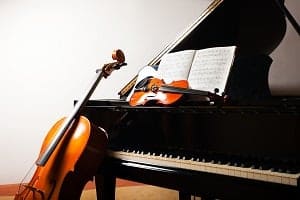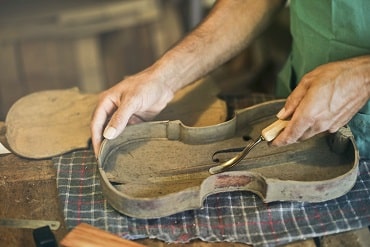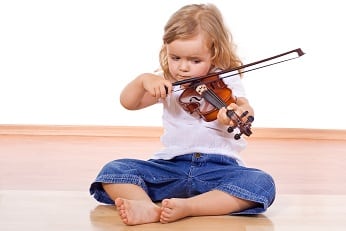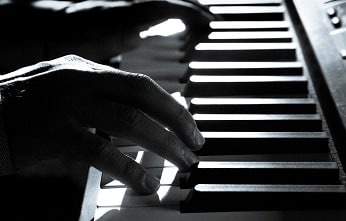As an Amazon Associate I earn from qualifying purchases.
I’m a lover of music of all types. In fact, growing up I played in the high school marching band, so I certainly have an appreciation for other instruments outside of the piano. One instrument that’s always intrigued me over the years though is the violin.
When comparing piano vs violin there are a number of things to consider. Here are a couple of key differences and similarities between piano and violin.
- Pianos are more expensive
- Violins are more portable
- Violin is more fragile compared to piano
- Violin has a stiffer learning curve
- Both instruments are great for ensemble playing
- Piano has more harmonic versatility
- Pianos have less overall maintenance costs
Want to Learn Piano?Click Here

As a young musician it can sometimes be a tough decision to choose your first musical instrument. Violin and piano are by far the most popular choices out there, but there’s a lot of options out there. Check out this helpful guide for choosing your first musical instrument.
Even some of my beginner students find themselves conflicted about which instrument they should start with even after they’ve chosen the piano!
When deciding between piano and violin you might be wondering which one is harder to learn. Maybe you’re thinking about your child’s future as a professional musician or have concerns with costs and quality.
Then there’s the social aspect of everything too making sure that students can learn together in ensemble and not be so isolated.
I’m going to cover all of those concerns throughout this article. My goal is not necessarily to make you choose the piano, but hopefully I can help you understand some of the main differences between the piano and violin.
To simplify things I’ve organized a list of 7 things to consider when comparing piano vs violin. I think with this information you’ll have a much clearer picture of which instrument you should choose.
1. Pianos Are More Expensive
Most upright pianos range anywhere from $3000 – $5000. Higher quality uprights can run up to $10,000. For the more advanced player a grand piano is a logical choice, but will run you around $15,000 for a low end model.
Then of course there is Steinway which I consider to be the cream of the crop. A standard 7′ Steinway B now costs in excess of $120,000! For this reason I suggest students and adults to start out with something less expensive, but that can function well enough to develop playing skills.
The Yamaha DGX-660 is an excellent piano with weighted action that mimics an acoustic instrument. It also has different sounds, a built-in metronome and other music modes to keep things fresh and exciting.
Violins like the Yamaha V3 have a lower entry point than pianos, and that makes them an attractive buy for parents of new students. Like pianos, violins are produced for various experience levels.
Student violins might have limited features, and professional models will have all of the bells and whistles. For really young students there are smaller sized instruments that make it easier to grip the, have easier access to the fingerboard, and are easier to tune.
2. Violins Are More Portable
As a concert pianist, whenever I travel there’s really no opportunity to practice because I can’t bring my piano with me.
Even if i’m flying somewhere, bringing a portable keyboard isn’t really an option either. As a professional I’ve learned how to prepare well for those situations, but as a developing musician that can be a potential problem.
Because pianos lack portability, working on your craft depends heavily on being in one location all the time. Even if you do travel quite a bit there’s plenty of hurdles to go through just to get a decent practice session in.
Pianists have to do things like rent practice space, reach out to churches and schools, and even walk into music showrooms just to get access to an instrument. As a novice pianist it’s not such a big deal, but as a professional who needs 7 hours per day of practice it’s a real drag.
Outside of the practice elements are the performance issues. Every piano is not created equal, and sometimes you never know what you’ll get. Some venues may have amazing pianos and others might be terrible.
As the pianist you have no control over this and it’s always a slight acclamation period when performing on a different instrument. I can’t really think of any other instrument that presents this kind of problem when it comes to portability.
This my friend is why I think the portability of a violin lends itself well to both young students and performances.
Violins are small enough to pack up in a car, take on a flight across the country or even take to the local park. As a student develops it’s important to have an instrument that they always have access to.
Even at the professional level, violinists always know what they’re instrument is going to sound like. They practice on it every day and never have to worry about having access to it.
If it’s the night before a recital or audition even you can simply whip out the instrument and play through passages. Pianists don’t have that advantage and at most can only get by with a keyboard.
3. Violins Are More Fragile Compared To Piano
Young students who take up the violin need to be really careful with the instrument. Unlike the piano, the violin is much more fragile. It’s a much smaller instrument and it has very delicate parts that are exposed to the open. Simply dropping of the violin can cause all kinds of problems.
As a new student trying to get a grip on the chin rest and proper posture drops like that can happen. Also kids are going to be kids, and might get a little careless with the instrument.

Leaving it out in the open on the ground can lead to the violin getting stepped on. Over-tightening while tuning can also lead to broken strings too. You should always encourage young students to place their violin in the protective shell case.
The piano on the other hand is a lot less fragile than a violin. At most being careless could result in a couple of blemishes to the casing and finish. I’ve seen many pianos with small dents and scratches and dust; yet they still play wonderfully.
A good way to avoid those scratches and chips is to use a thick piano cover to keep the instrument in great shape. There’s also protective fabrics that you can lay on top of the keyboard to keep the dust out.
It’s not an instrument that you’ll be moving around very much, and it’s always going to have a dedicated space just for practice. Pianos are subject to some mechanical and tuning issues when it comes to humidity control. As long as you regulate the temperatures in the home it should hold it’s tune for a while.
4. Violin Has A Stiffer Learning Curve

Both instruments are difficult to master, but when it comes to the start violin is much tougher. There are all sorts of awkward positions that you would need to learn. Things like how to hold the bow, placing the chin rest at just the right angle and more.
The other tough thing with violin is that you need to develop a strong ear early on with the tuning process. Young students might accidentally snap a few strings in the process. Musically knowing where exactly to place your bow isn’t an exact science.
It’ll take new students some time to really polish their ability to quickly change positions while producing a solid tone.
Piano, on the other hand, takes a lot of the guesswork out of the equation. These instruments already come tuned, so it’s something a student can sit down and start playing right away.
If it needs a tune you simply call one up and they’ll calibrate your instrument. Determining where the notes are is much easier on piano too.
The octaves follow a consistent pattern of whole and half steps. You could have a student playing several pieces on day one when it comes to piano vs the violin.
Certainly, the challenges with piano will be establishing proper bench height, having good postures and finger placement. The good thing is that it’s an instrument you can learn one hand at a time if you wanted to and still accomplish great results.
In the long run I believe piano will end up being the more difficult instrument. The repertoire will become much more demanding from a technical standpoint.
Having fluid dexterity in both hands will be important if you want to continue developing as a pianist. The good thing is that in the early stages of learning you have an opportunity to really hone in on those skills through simple repertoire.
5. Both Instruments Are Great For Ensemble Playing
This is an often overlooked issue when comparing piano vs violin or any other kind of string instrument. Pianists typically play alone the majority of the time. This can be during practice and also in recital situations.
Of course there’s the prospects of performing a piano concerto or doing some duo piano work too. Then there’s the implementation of group piano classes in recent years to build some social music making.
When someone plays the piano in the Classical field they often aren’t doing much collaborative playing in general. Violinists on the other hand build much of their musical skill and creativity off of collaboration.
Violinists play with pianists whenever they give public recitals, or even with orchestras as well. When they’re not doing that they are participating with others in chamber quartets and quintets.
As a young musician it’s important to participate in group activities. I think that violin gives students those students a better chance at that. Ensemble playing is starting to be implemented in the piano world though, especially for those enrolled in music academies and higher quality programs.
6. Piano Has More Harmonic Versatility

One of the big benefits of playing the piano is the ability to make all types of music. It’s an instrument that offers a ton of harmonic versatility. You have the ability to play single notes, rich chords and much more.
There of course there’s fun techniques like trills, octave passages and glissando’s. You can even hold chords in one hand while producing a gorgeous melody in another which makes this instrument so unique. Those facts alone will naturally make it a more enjoyable instrument to play; especially as pianists hand coordination improves.
Violin can do many of the same things a piano can, although in a limited fashion and much more difficult to pull off without serious skill. I find it to be an excellent instrument when it comes to showing off virtuosity, finger speed and emotion especially.
There’s the ability to play chords on violin too much as you would with a guitar, but it doesn’t have the same effect the piano has. The violin has a much different tone and I find that it’s a little limiting in that regard.
The piano has more depth of sound and the tonal span is much larger overall. Piano is also an extremely dynamic instrument too.
7. Pianos Require Very Little Maintenance
I love the piano because it’s such a low maintenance instrument. Just keep the temperature regulated, make sure it’s covered and tune it twice a year. Proper tuning will run you anywhere from $150 – $200 each time which isn’t too bad.
If you need anything else done to the piano like voicing and lubrication of the keys that might run you a few bucks over. It’ll be probably decades before any piano would need a major overhaul. That includes things like replacing the hammers, cosmetic repairs and rebuilding the action.
Violins seem to cost a little more to maintain over the years. We already looked at how fragile they are, and crushing a violin almost always means you need to purchase a new one. Violins will need routine cleanings, string replacements, peg replacements, bridge adjustments and more as it ages.
Repair costs depend on many factors, but the instrument level type plays a factor. Student models might experience repairs in the $60 – $70 range, and more professional models will be in excess of $100. Cracks are obviously more expensive being north of $250.
Depending on the extent of the damage, some violin neck repairs cost north of $1700. Because it’s such a tedious instrument to work with compared to the piano, you’re paying more for the labor and expertise of your technician.
Final Thoughts
As you can see there’s a lot of positives and negatives to both instruments. I’m a pianist, so of course I’m a little biased, but I truly feel like it’s the better instrument. It’s a really fun instrument to be around, and I find that it allows for more creative diversity.
While it’s a bigger investment than a violin, the overall maintenance costs are going to be less in the long run. Pianos are built to last for several decades; especially if you invest in something like a Yamaha or Steinway.
Violin is still a great instrument too. If you decide to choose the violin that’s great as well! The learning curve will be a little tough to work through initially, but once the skills are honed in through diligent practice and focus it’l be really fun to play.
I like that violin offers plenty of ensemble opportunities, and that’s something students will need in order to be as creative as they can be. The portability of the instrument makes it a very attractive choice as well.
If you plan to start violin then I recommend checking out the Bunnell Pupil Full Size Violin or the Yamaha V3.
Hello & thanks for stopping by! I’m a professional concert pianist and piano instructor. In the United States, I’ve given successful performances in several places including New York, Florida, Connecticut, & New Jersey, I have also performed internationally in Italy and made my Carnegie Hall debut in 2014. I enjoy blogging about the piano, the art of performance, general music, current events and the latest in music production.
